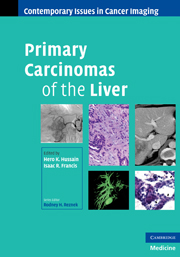Book contents
- Frontmatter
- Contents
- Contributors
- Series foreword
- Preface to Primary Carcinomas of the Liver
- 1 Epidemiology of hepatocellular carcinoma and cholangiocarcinoma
- 2 Surveillance and screening for hepatocellular carcinoma
- 3 Pathology of hepatocellular carcinoma, cholangiocarcinoma, and combined hepatocellular-cholangiocarcinoma
- 4 Radiological diagnosis of hepatocellular carcinoma
- 5 Staging of hepatocellular carcinoma
- 6 Surgical treatment of hepatocellular carcinoma: resection and transplantation
- 7 Non-surgical treatment of hepatocellular carcinoma
- 8 Radiological identification of residual and recurrent hepatocellular carcinoma
- 9 Radiological diagnosis of cholangiocarcinoma
- 10 Staging of cholangiocarcinoma
- 11 Treatment of cholangiocarcinoma
- 12 Uncommon hepatic tumors
- Index
- Color plates
- References
6 - Surgical treatment of hepatocellular carcinoma: resection and transplantation
Published online by Cambridge University Press: 04 August 2010
- Frontmatter
- Contents
- Contributors
- Series foreword
- Preface to Primary Carcinomas of the Liver
- 1 Epidemiology of hepatocellular carcinoma and cholangiocarcinoma
- 2 Surveillance and screening for hepatocellular carcinoma
- 3 Pathology of hepatocellular carcinoma, cholangiocarcinoma, and combined hepatocellular-cholangiocarcinoma
- 4 Radiological diagnosis of hepatocellular carcinoma
- 5 Staging of hepatocellular carcinoma
- 6 Surgical treatment of hepatocellular carcinoma: resection and transplantation
- 7 Non-surgical treatment of hepatocellular carcinoma
- 8 Radiological identification of residual and recurrent hepatocellular carcinoma
- 9 Radiological diagnosis of cholangiocarcinoma
- 10 Staging of cholangiocarcinoma
- 11 Treatment of cholangiocarcinoma
- 12 Uncommon hepatic tumors
- Index
- Color plates
- References
Summary
Hepatocellular carcinoma (HCC) represents approximately 80–90% of primary liver malignancies around the world, and its prevalence parallels that of chronic liver disease. Its incidence peaks between the ages of 50 and 70 years, and it is more common in men than in women. Risk factors include cirrhosis, chronic hepatitis, carcinogens, and inborn errors of metabolism. HCCs can be solitary, multicentric, diffuse, as well as infiltrating. The tumor may invade adjacent vascular structures or metastasize to the lungs, adrenal glands, lymph nodes, or bone. After HCC is diagnosed, the overall survival is poor, with an approximate 50% mortality within the first year following diagnosis. Survival is associated with the size of the tumor, the number of satellite lesions, and overall hepatic function. As a result, high-risk surveillance programs have been initiated in many areas throughout the world to detect early-stage tumors. Furthermore, advancements in imaging have allowed for identification of these malignancies at earlier stages. The end result has allowed for increasingly higher rates of potential cure by either resection or transplantation.
Patients with HCC frequently have underlying cirrhotic liver disease. Hepatic dysfunction and cirrhosis-related portal hypertension, however, can be limiting factors for surgical resection. The first line of therapy for HCC continues to be surgical resection. However, decreased hepatic reserve and portal hypertension make surgical resection in cirrhotic patients increasingly more tenuous and are associated with increased morbidity and mortality. Cirrhotic patients also have a high rate of cancer recurrence.
- Type
- Chapter
- Information
- Primary Carcinomas of the Liver , pp. 57 - 65Publisher: Cambridge University PressPrint publication year: 2009



